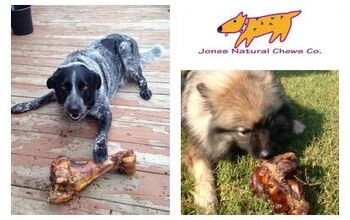The Importance Of Raw Bones For Dogs

As a responsible dog owner, you probably already know how dangerous it is to give your dog chicken bones. Chicken bones are fragile, likely to splinter or break and get caught in your dog’s throat. You shouldn’t assume, however, that all bones are bad for dogs. In fact, raw bones are very nutritionally valuable for dogs. We’re going to go over just how important raw bones are for dogs and how you can incorporate them in your dog’s diet.
Nutrition of Raw Bones
When you look at a bone, all you may see is a hard object for your dog to chew on. In reality, however, raw bones provide a variety of essential nutrients for your dog. Raw bones are primarily composed of calcium phosphate, a mineral that helps your dog to grow properly. This mineral is especially important for large-breed puppies who tend to grow very quickly and need extra calcium phosphate to strengthen their bones. While many commercial dog foods contain calcium, it is equally important that your dog’s diet contains a balanced calcium-to-phosphorus ratio. This is where raw bones come in. In addition to the bone itself, raw bones also contain marrow. Bone marrow contains fat and various blood components which, in and of themselves, are nutritionally valuable for dogs.
Bones in Commercial Dog Food
Because bones contain valuable nutrients for dogs, they are a common ingredient in many commercial dog food formulas. Unfortunately, the type of bone used in these formulas is typically not fresh – it is usually some type of bone meal or ash. In many cases, the bones are steamed or pressure cooked to remove fat and tissue (the parts that contain vital nutrients). The remaining product is then ground and dried, used as a filler for the dog food. It is also important to note that some bone meal used by US pet food manufacturers is imported from China – thus, it likely exceeds safety limits for heavy metals and other dangerous materials.
Giving Your Dog Raw Bones
If you want your dog to benefit from the healthy nutrients in raw bones, you have several options – you can switch your dog to a raw food formula, you can supplement his diet with microcrystalline hydroxyapatite (MCH) or you can feed him raw bones.
Raw Dog Food: Many pet food manufacturers have started to offer raw dog food formulas. These foods are typically found in the refrigerated or frozen dog food section of your pet store – they can also be ordered online. These foods are typically made with a combination of raw meat and bone as well as other nutritious ingredients like eggs and easily digested vegetables. As well, many pet parents make their own raw food from scratch. Keep The Tail Wagging is one of our favorite sites on the subject, where dog mom Kimberley Gauthier talks about her experiences feeding a raw diet to her four dogs.
MCH: Microcrystalline hydroxyapatite, or MCH, is freeze-dried bone. This product is typically imported from New Zealand and it is the most high quality bone replacement available for pets. To create MCH, raw bone is freeze-dried and then powdered.
Raw Bones: There are two ways to offer your dog raw bones – by grinding bone and adding it to his food or by giving him a large recreational bone to chew. Soft, hollow bones like the wings or necks of poultry can be crushed in a meat grinder and added to your dog’s food. For recreational bones, use hip or femur bones from large animals like cows and bison – these bones will be filled with marrow.
Adding some raw bone to your dog’s diet will not only improve his nutrition, but it can be fun for him as well – especially if you give him a big, meaty bone to chew on. Always supervise your dog when you give him a recreational bone in case pieces of it break off – these should be removed because they could become choking hazards.

Kate Barrington is the loving owner of two cats (Bagel and Munchkin) and a noisy herd of guinea pigs. Having grown up with golden retrievers, Kate has a great deal of experience with dogs but labels herself a lover of all pets. Having received a Bachelor's degree in English, Kate has combined her love for pets and her passion for writing to create her own freelance writing business, specializing in the pet niche.
More by Kate Barrington























